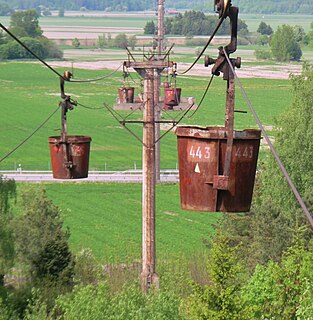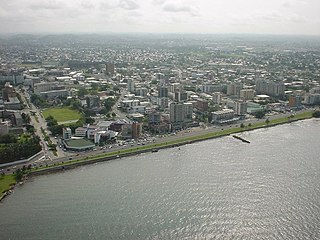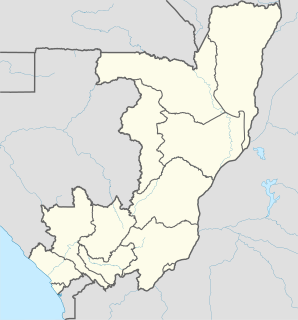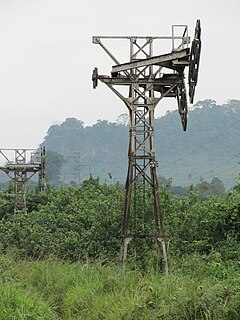The COMILOG Cableway was one of the longest cableways in the world, until its closure in 1986. [1] The ropeway conveyor ran for 76 km from Moanda in the Haut-Ogooué Province of south eastern Gabon to Mbinda in the Republic of Congo.

A ropeway conveyor or material ropeway is essentially a subtype of gondola lift, from which containers for goods rather than passenger cars are suspended.

Moanda is one of the largest towns in Gabon, lying on the N3 road in Haut Ogooué. It is also one of the most important manganese mining towns in the world, under the auspices of the Compagnie Minière de l'Ogooué (COMILOG), which began mining in 1957. Moanda has a population of around 39,298 inhabitants and is the second largest city in the Haut Ogooué Region, after Franceville. It is also a border town, lying 100 km away from the border with the Republic of Congo.

Haut-Ogooué is the southeastern-most of Gabon's nine provinces. It is named after the Ogooué River. It covers an area of 36,547 km². The provincial capital is Franceville. One of its primary industries is mining, with manganese, gold and uranium being found in the region. The uranium-bearing mineral Francevillite takes its name from the primary city. It is the historical home of three cultures, the Obamba, Ndzabi and Téké. Like many regions in Africa, more traditional uses of the land have given way to rural migration to the larger cities. In August 2006, its soccer club won the Gabon Independence Cup.
Contents
In 1954, the Compagnie Minière de l'Ogooué (COMILOG), a French-American company formed the previous year, decided to begin mining manganese in the Gabonese town of Moanda. The town lay deep in the rainforest, and export of the metal was a problem. The nearest reliable transport route was the Congo-Ocean Railway, but this lay more than 250km away, across difficult terrain. George Perrineau was charged with constructing a transport link between the two. [2]

Mining is the extraction of valuable minerals or other geological materials from the earth, usually from an ore body, lode, vein, seam, reef or placer deposit. These deposits form a mineralized package that is of economic interest to the miner.

Manganese is a chemical element with symbol Mn and atomic number 25. It is not found as a free element in nature; it is often found in minerals in combination with iron. Manganese is a metal with important industrial metal alloy uses, particularly in stainless steels.

Rainforests are forests characterized by high rainfall, with annual rainfall in the case of tropical rainforests between 250 and 450 centimetres, and definitions varying by region for temperate rainforests. The monsoon trough, alternatively known as the intertropical convergence zone, plays a significant role in creating the climatic conditions necessary for the Earth's tropical rainforests.
It was decided to construct a cableway from Moanda to Mbinda, and then branch of the Congo-Ocean Railway to Mont Bello, from which the existing railway would link to the port of Pointe-Noire. [3] The conveyor was routed via the small town of Bakoumba, which became the centre for the maintenance of the structure. [4] The mine opened in 1957, and the Cableway was opened in 1959, the link finally being completed when the Congo-Ocean Railway branch opened in 1962. [3]

A port is a maritime commercial facility which may comprise one or more wharves where ships may dock to load and discharge passengers and cargo. Although usually situated on a sea coast or estuary, some ports, such as Hamburg, Manchester and Duluth, are many miles inland, with access from the sea via river or canal.

Pointe-Noire is the second largest city in the Republic of the Congo, following the capital of Brazzaville, and an autonomous department since 2004. Before this date it was the capital of the Kouilou region. It is situated on a headland between Pointe-Noire Bay and the Atlantic Ocean. Pointe-Noire is the main commercial centre of the country and has a population of 715,334 (2007), expanding to well over 1 million when the entire metropolitan area is taken into account.

Bakoumba is a town in south eastern Gabon with a population of around 2,500 - 3000 people. It lies south west of Moanda and was the headquarters for the COMILOG Cableway, carrying manganese from Moanda to Mbinda in Republic of Congo. The cable car closed in 1986.
The Cableway consisted of ten sections, and had 858 supports of between 5 and 74m in height. [5] One tonne cars carried the manganese twenty-four hours a day. [6]
The government of Gabon was keen to ship the valuable manganese ore through its own ports, and routed a new railway, the Transgabonais, from the national capital Libreville to Moanda, and on to Franceville. When this opened, in 1986, the cableway was closed. While Moanda continued to prosper, Bakoumba and Mbinda suffered from the withdrawal of their main industry. COMILOG funded the creation of the Lékédi Park at Bakoumba to encourage the development of a tourist industry, [6] but some groups in Congo felt that unemployment there was not addressed. [3]

Libreville is the capital and largest city of Gabon, in western central Africa. The city is a port on the Komo River, near the Gulf of Guinea, and a trade center for a timber region. As of 2013, its census population was 703,904. The area was originally inhabited by the Mpongwé tribe before the French acquired the land in 1839. In 1846, a Brazilian slave ship was captured by the French navy assisting the British Blockade of Africa, and fifty-two of the freed slaves were resettled on the site. It became the chief port of French Equatorial Africa from 1934 to 1946, and was the central focus of the Battle of Gabon in 1940. Libreville was named in imitation of Freetown, and grew slowly as a trading post and a minor administrative centre, reaching a population of 32,000 on independence in 1960. Since independence, the city has grown rapidly and now houses nearly half the national population. It is home to a shipbuilding industry, brewing industry, and sawmills, and exports raw materials such as wood, rubber and cocoa.










